Ngee Ann Polytechnic Nursing Research Critique: Depression and QOL
VerifiedAdded on 2020/04/21
|23
|4852
|69
Report
AI Summary
This report is a comprehensive critique of a quantitative research study focusing on the prevalence of depression and its association with the quality of life among patients undergoing cancer treatment, specifically breast cancer. The report, prepared for a Nursing Research course at Ngee Ann Polytechnic, evaluates the study's title, abstract, introduction, literature review, and research design, assessing their clarity, accuracy, and relevance. The critique examines the study's methodology, including the use of the Patient Health Questionnaire 9 and the World Health Organization Quality of Life (WHOQOL-BREF) questionnaire. It analyzes the study's findings, which indicated a correlation between depression and cancer treatment, leading to a decline in the quality of life. The report provides detailed analysis of the study's strengths and weaknesses, including the appropriateness of the length of the title and abstract, clarity of the introduction, and the logical sequence of the literature review. The report also evaluates the research gap, aims, hypotheses, and variables, offering insights into the study's contribution to nursing practice and research. Overall, the report offers a critical assessment of the research study's design, execution, and implications for nursing practice, highlighting areas for improvement and further research.

Running head: NURSING RESEARCH
Prevalence of Depression and Detoriation of QOL among patients undergoing
cancer treatment.
Name of the Student
Name of the University
Author Note
Prevalence of Depression and Detoriation of QOL among patients undergoing
cancer treatment.
Name of the Student
Name of the University
Author Note
Paraphrase This Document
Need a fresh take? Get an instant paraphrase of this document with our AI Paraphraser
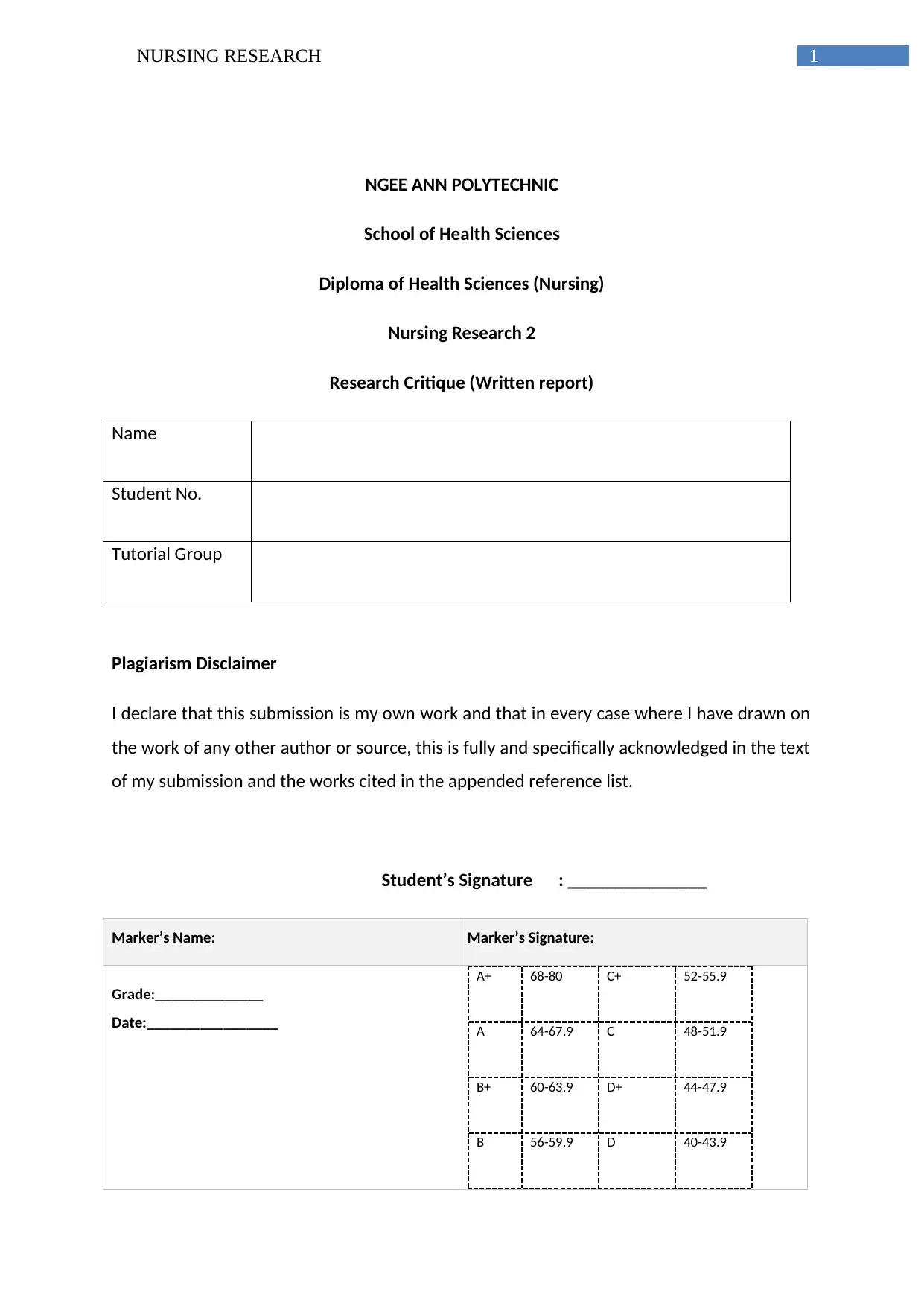
1NURSING RESEARCH
NGEE ANN POLYTECHNIC
School of Health Sciences
Diploma of Health Sciences (Nursing)
Nursing Research 2
Research Critique (Written report)
Name
Student No.
Tutorial Group
Plagiarism Disclaimer
I declare that this submission is my own work and that in every case where I have drawn on
the work of any other author or source, this is fully and specifically acknowledged in the text
of my submission and the works cited in the appended reference list.
Student’s Signature : _______________
Marker’s Name: Marker’s Signature:
Grade:______________
Date:_________________
A+ 68-80 C+ 52-55.9
A 64-67.9 C 48-51.9
B+ 60-63.9 D+ 44-47.9
B 56-59.9 D 40-43.9
NGEE ANN POLYTECHNIC
School of Health Sciences
Diploma of Health Sciences (Nursing)
Nursing Research 2
Research Critique (Written report)
Name
Student No.
Tutorial Group
Plagiarism Disclaimer
I declare that this submission is my own work and that in every case where I have drawn on
the work of any other author or source, this is fully and specifically acknowledged in the text
of my submission and the works cited in the appended reference list.
Student’s Signature : _______________
Marker’s Name: Marker’s Signature:
Grade:______________
Date:_________________
A+ 68-80 C+ 52-55.9
A 64-67.9 C 48-51.9
B+ 60-63.9 D+ 44-47.9
B 56-59.9 D 40-43.9
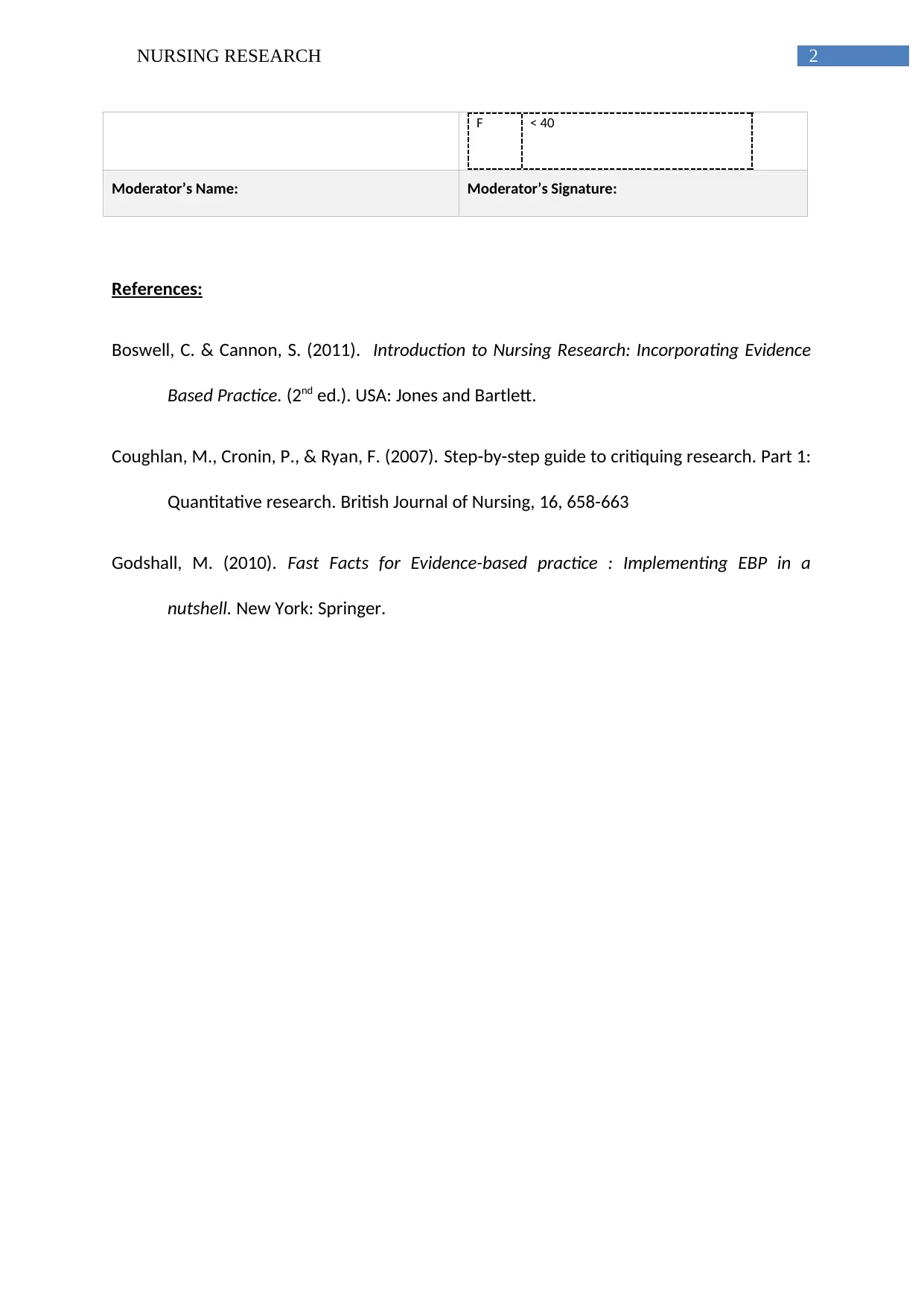
2NURSING RESEARCH
F < 40
Moderator’s Name: Moderator’s Signature:
References:
Boswell, C. & Cannon, S. (2011). Introduction to Nursing Research: Incorporating Evidence
Based Practice. (2nd ed.). USA: Jones and Bartlett.
Coughlan, M., Cronin, P., & Ryan, F. (2007). Step-by-step guide to critiquing research. Part 1:
Quantitative research. British Journal of Nursing, 16, 658-663
Godshall, M. (2010). Fast Facts for Evidence-based practice : Implementing EBP in a
nutshell. New York: Springer.
F < 40
Moderator’s Name: Moderator’s Signature:
References:
Boswell, C. & Cannon, S. (2011). Introduction to Nursing Research: Incorporating Evidence
Based Practice. (2nd ed.). USA: Jones and Bartlett.
Coughlan, M., Cronin, P., & Ryan, F. (2007). Step-by-step guide to critiquing research. Part 1:
Quantitative research. British Journal of Nursing, 16, 658-663
Godshall, M. (2010). Fast Facts for Evidence-based practice : Implementing EBP in a
nutshell. New York: Springer.
⊘ This is a preview!⊘
Do you want full access?
Subscribe today to unlock all pages.

Trusted by 1+ million students worldwide
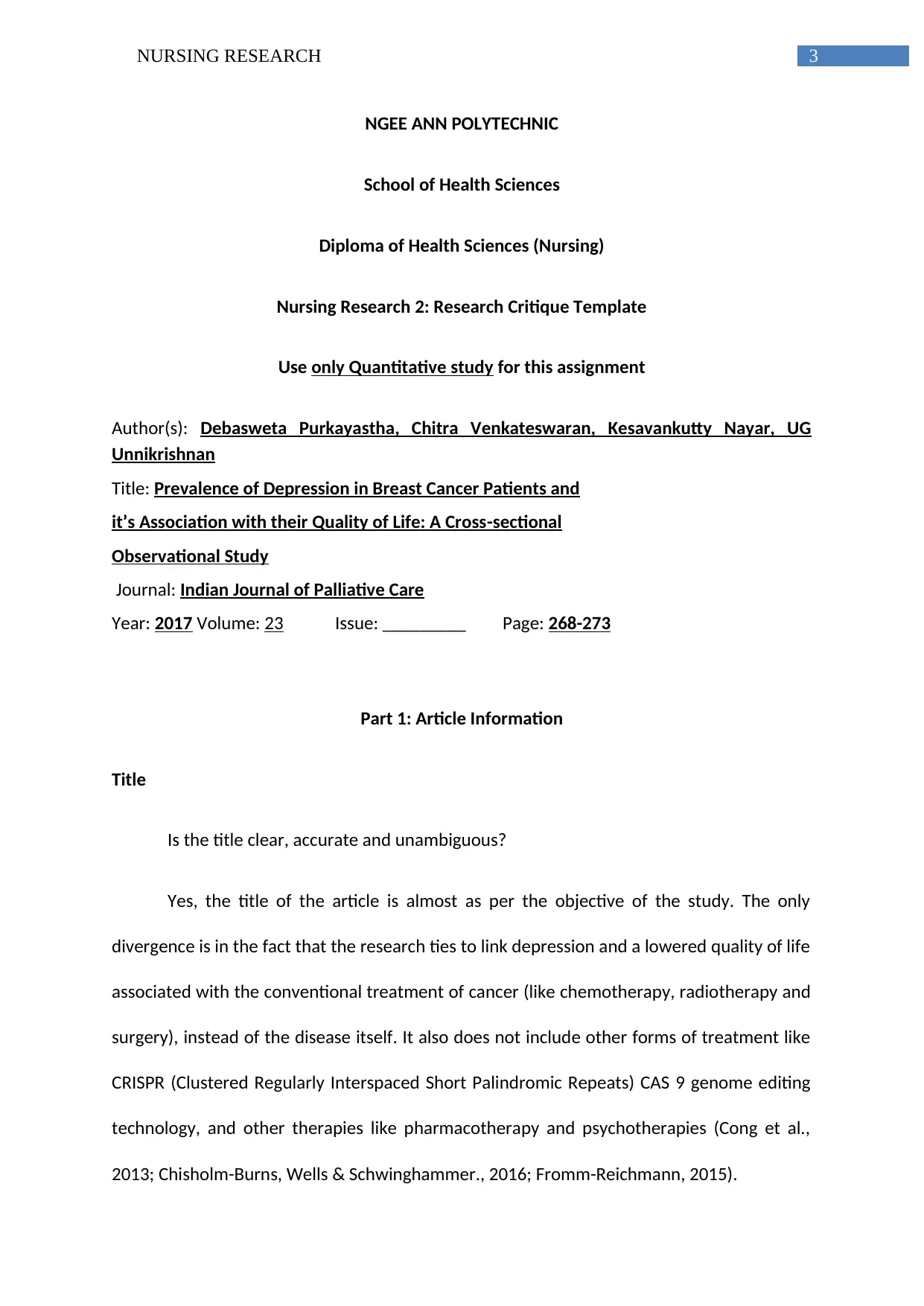
3NURSING RESEARCH
NGEE ANN POLYTECHNIC
School of Health Sciences
Diploma of Health Sciences (Nursing)
Nursing Research 2: Research Critique Template
Use only Quantitative study for this assignment
Author(s): Debasweta Purkayastha, Chitra Venkateswaran, Kesavankutty Nayar, UG
Unnikrishnan
Title: Prevalence of Depression in Breast Cancer Patients and
it’s Association with their Quality of Life: A Cross-sectional
Observational Study
Journal: Indian Journal of Palliative Care
Year: 2017 Volume: 23 Issue: _________ Page: 268-273
Part 1: Article Information
Title
Is the title clear, accurate and unambiguous?
Yes, the title of the article is almost as per the objective of the study. The only
divergence is in the fact that the research ties to link depression and a lowered quality of life
associated with the conventional treatment of cancer (like chemotherapy, radiotherapy and
surgery), instead of the disease itself. It also does not include other forms of treatment like
CRISPR (Clustered Regularly Interspaced Short Palindromic Repeats) CAS 9 genome editing
technology, and other therapies like pharmacotherapy and psychotherapies (Cong et al.,
2013; Chisholm-Burns, Wells & Schwinghammer., 2016; Fromm-Reichmann, 2015).
NGEE ANN POLYTECHNIC
School of Health Sciences
Diploma of Health Sciences (Nursing)
Nursing Research 2: Research Critique Template
Use only Quantitative study for this assignment
Author(s): Debasweta Purkayastha, Chitra Venkateswaran, Kesavankutty Nayar, UG
Unnikrishnan
Title: Prevalence of Depression in Breast Cancer Patients and
it’s Association with their Quality of Life: A Cross-sectional
Observational Study
Journal: Indian Journal of Palliative Care
Year: 2017 Volume: 23 Issue: _________ Page: 268-273
Part 1: Article Information
Title
Is the title clear, accurate and unambiguous?
Yes, the title of the article is almost as per the objective of the study. The only
divergence is in the fact that the research ties to link depression and a lowered quality of life
associated with the conventional treatment of cancer (like chemotherapy, radiotherapy and
surgery), instead of the disease itself. It also does not include other forms of treatment like
CRISPR (Clustered Regularly Interspaced Short Palindromic Repeats) CAS 9 genome editing
technology, and other therapies like pharmacotherapy and psychotherapies (Cong et al.,
2013; Chisholm-Burns, Wells & Schwinghammer., 2016; Fromm-Reichmann, 2015).
Paraphrase This Document
Need a fresh take? Get an instant paraphrase of this document with our AI Paraphraser
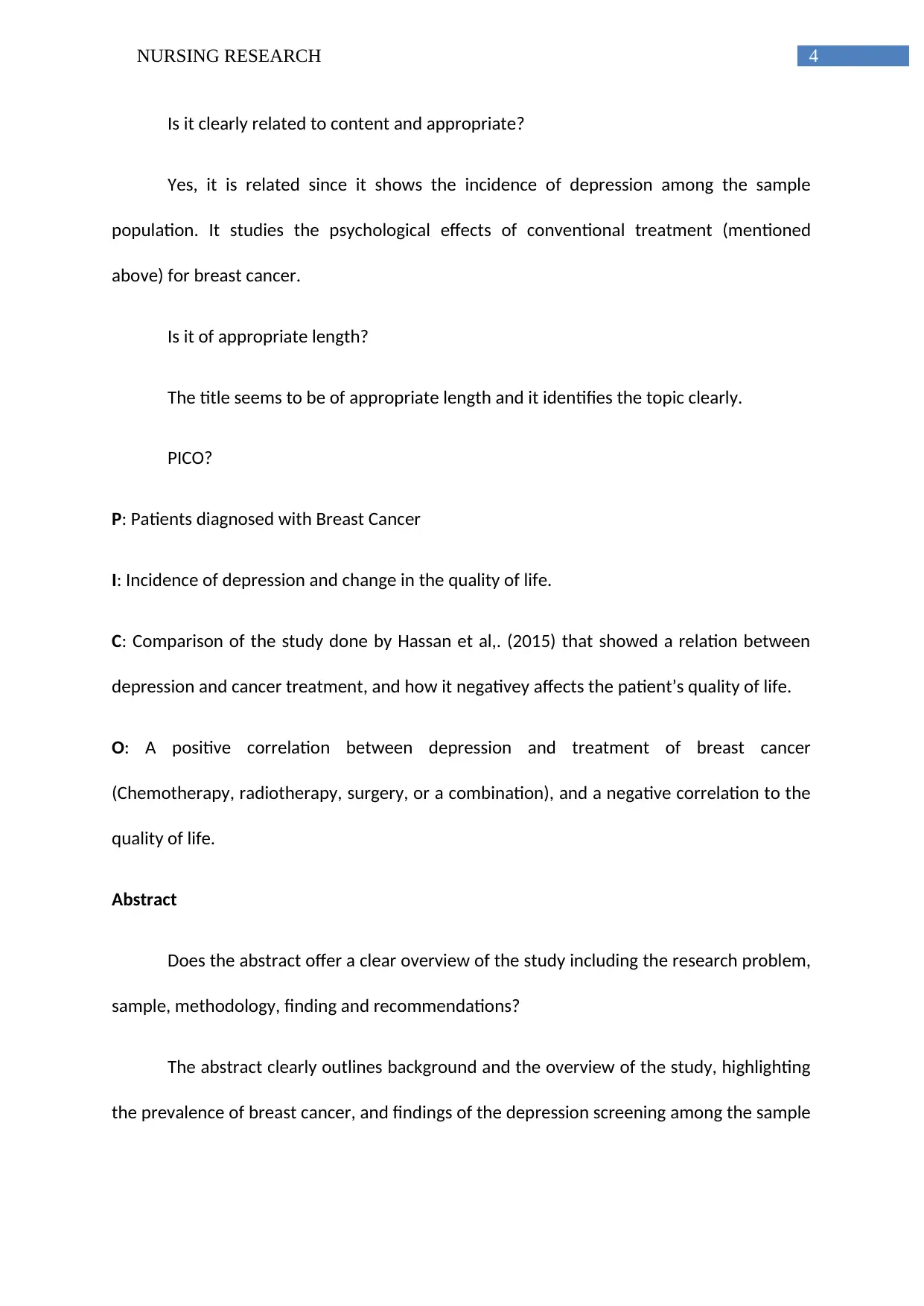
4NURSING RESEARCH
Is it clearly related to content and appropriate?
Yes, it is related since it shows the incidence of depression among the sample
population. It studies the psychological effects of conventional treatment (mentioned
above) for breast cancer.
Is it of appropriate length?
The title seems to be of appropriate length and it identifies the topic clearly.
PICO?
P: Patients diagnosed with Breast Cancer
I: Incidence of depression and change in the quality of life.
C: Comparison of the study done by Hassan et al,. (2015) that showed a relation between
depression and cancer treatment, and how it negativey affects the patient’s quality of life.
O: A positive correlation between depression and treatment of breast cancer
(Chemotherapy, radiotherapy, surgery, or a combination), and a negative correlation to the
quality of life.
Abstract
Does the abstract offer a clear overview of the study including the research problem,
sample, methodology, finding and recommendations?
The abstract clearly outlines background and the overview of the study, highlighting
the prevalence of breast cancer, and findings of the depression screening among the sample
Is it clearly related to content and appropriate?
Yes, it is related since it shows the incidence of depression among the sample
population. It studies the psychological effects of conventional treatment (mentioned
above) for breast cancer.
Is it of appropriate length?
The title seems to be of appropriate length and it identifies the topic clearly.
PICO?
P: Patients diagnosed with Breast Cancer
I: Incidence of depression and change in the quality of life.
C: Comparison of the study done by Hassan et al,. (2015) that showed a relation between
depression and cancer treatment, and how it negativey affects the patient’s quality of life.
O: A positive correlation between depression and treatment of breast cancer
(Chemotherapy, radiotherapy, surgery, or a combination), and a negative correlation to the
quality of life.
Abstract
Does the abstract offer a clear overview of the study including the research problem,
sample, methodology, finding and recommendations?
The abstract clearly outlines background and the overview of the study, highlighting
the prevalence of breast cancer, and findings of the depression screening among the sample
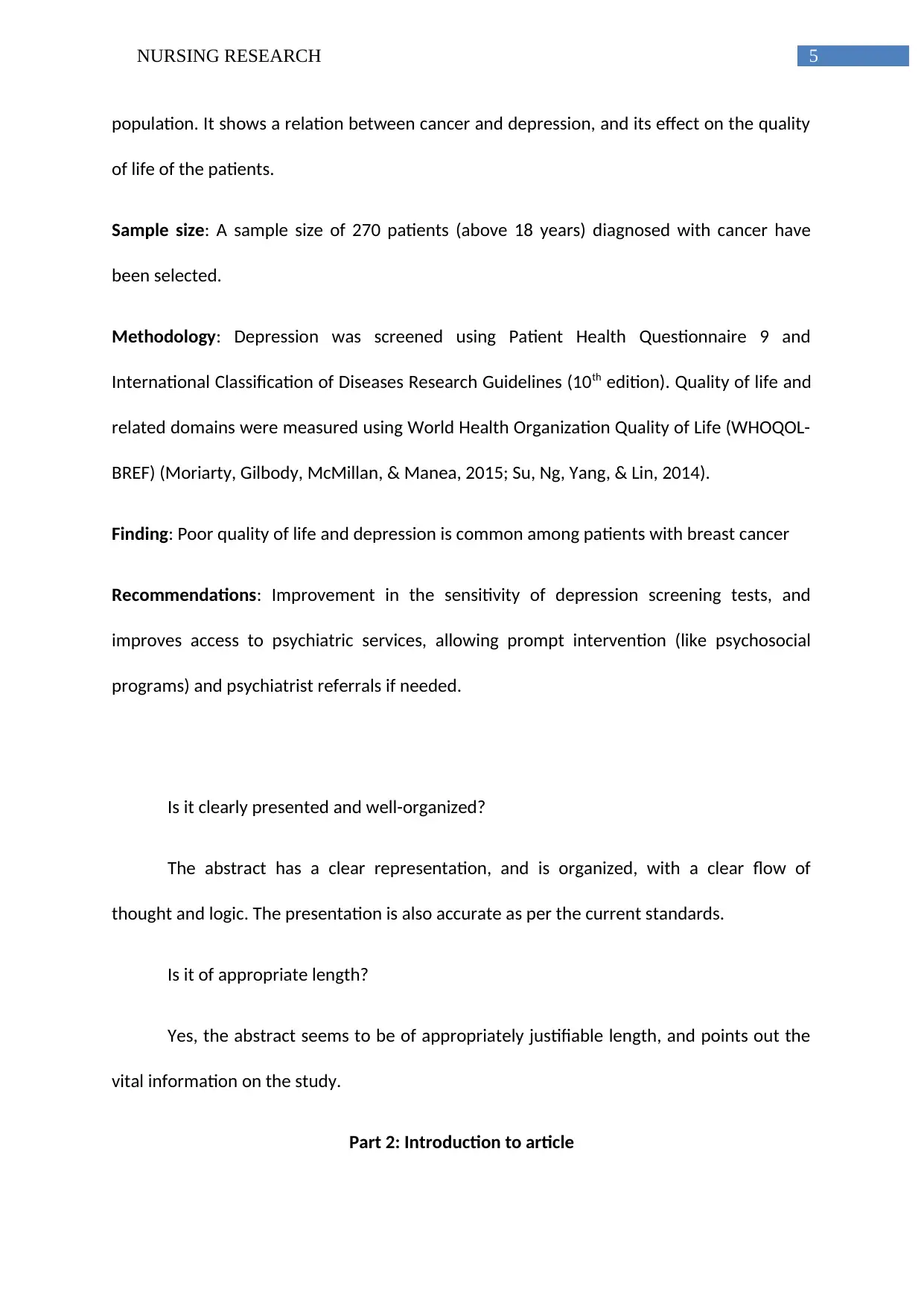
5NURSING RESEARCH
population. It shows a relation between cancer and depression, and its effect on the quality
of life of the patients.
Sample size: A sample size of 270 patients (above 18 years) diagnosed with cancer have
been selected.
Methodology: Depression was screened using Patient Health Questionnaire 9 and
International Classification of Diseases Research Guidelines (10th edition). Quality of life and
related domains were measured using World Health Organization Quality of Life (WHOQOL-
BREF) (Moriarty, Gilbody, McMillan, & Manea, 2015; Su, Ng, Yang, & Lin, 2014).
Finding: Poor quality of life and depression is common among patients with breast cancer
Recommendations: Improvement in the sensitivity of depression screening tests, and
improves access to psychiatric services, allowing prompt intervention (like psychosocial
programs) and psychiatrist referrals if needed.
Is it clearly presented and well-organized?
The abstract has a clear representation, and is organized, with a clear flow of
thought and logic. The presentation is also accurate as per the current standards.
Is it of appropriate length?
Yes, the abstract seems to be of appropriately justifiable length, and points out the
vital information on the study.
Part 2: Introduction to article
population. It shows a relation between cancer and depression, and its effect on the quality
of life of the patients.
Sample size: A sample size of 270 patients (above 18 years) diagnosed with cancer have
been selected.
Methodology: Depression was screened using Patient Health Questionnaire 9 and
International Classification of Diseases Research Guidelines (10th edition). Quality of life and
related domains were measured using World Health Organization Quality of Life (WHOQOL-
BREF) (Moriarty, Gilbody, McMillan, & Manea, 2015; Su, Ng, Yang, & Lin, 2014).
Finding: Poor quality of life and depression is common among patients with breast cancer
Recommendations: Improvement in the sensitivity of depression screening tests, and
improves access to psychiatric services, allowing prompt intervention (like psychosocial
programs) and psychiatrist referrals if needed.
Is it clearly presented and well-organized?
The abstract has a clear representation, and is organized, with a clear flow of
thought and logic. The presentation is also accurate as per the current standards.
Is it of appropriate length?
Yes, the abstract seems to be of appropriately justifiable length, and points out the
vital information on the study.
Part 2: Introduction to article
⊘ This is a preview!⊘
Do you want full access?
Subscribe today to unlock all pages.

Trusted by 1+ million students worldwide
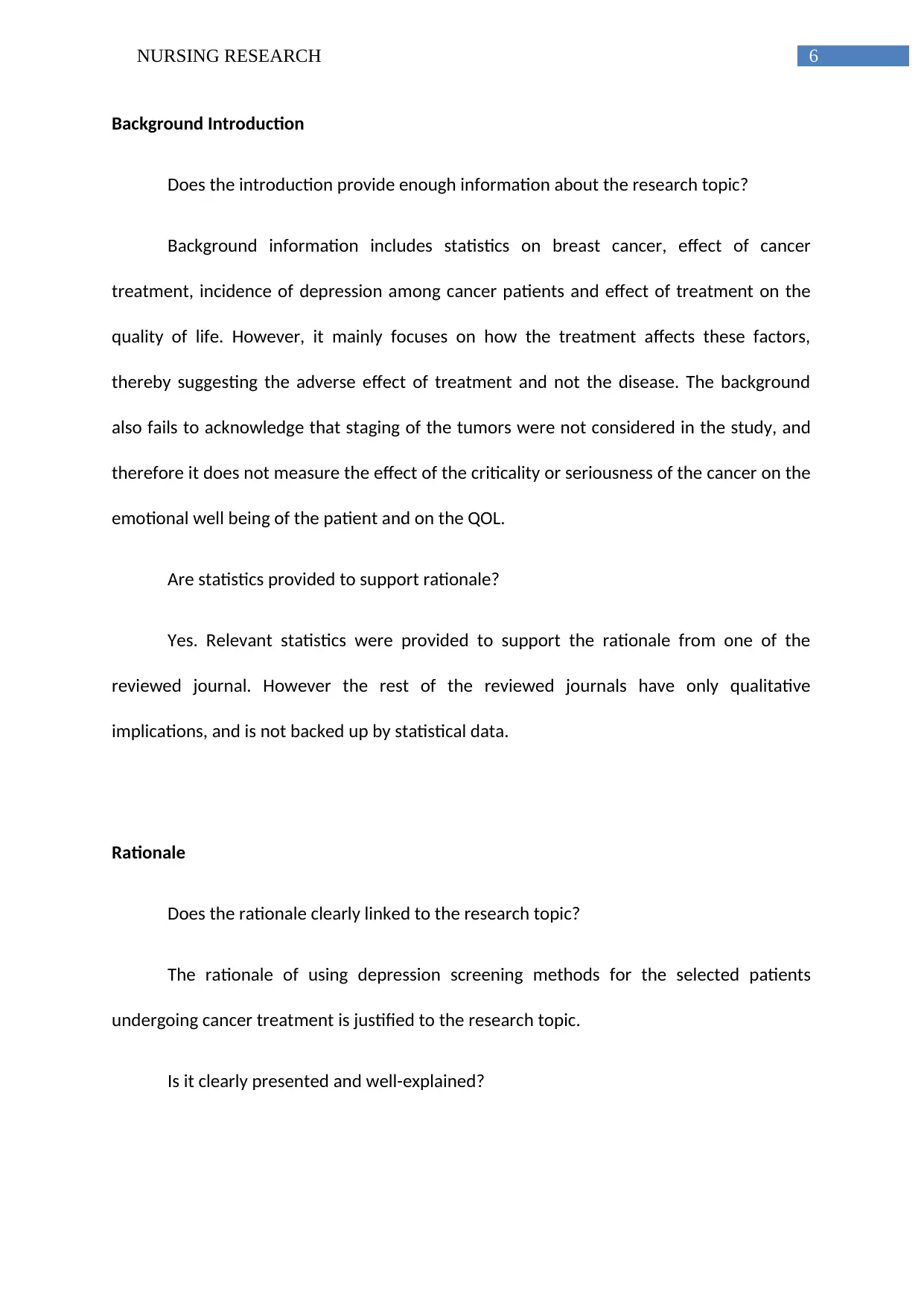
6NURSING RESEARCH
Background Introduction
Does the introduction provide enough information about the research topic?
Background information includes statistics on breast cancer, effect of cancer
treatment, incidence of depression among cancer patients and effect of treatment on the
quality of life. However, it mainly focuses on how the treatment affects these factors,
thereby suggesting the adverse effect of treatment and not the disease. The background
also fails to acknowledge that staging of the tumors were not considered in the study, and
therefore it does not measure the effect of the criticality or seriousness of the cancer on the
emotional well being of the patient and on the QOL.
Are statistics provided to support rationale?
Yes. Relevant statistics were provided to support the rationale from one of the
reviewed journal. However the rest of the reviewed journals have only qualitative
implications, and is not backed up by statistical data.
Rationale
Does the rationale clearly linked to the research topic?
The rationale of using depression screening methods for the selected patients
undergoing cancer treatment is justified to the research topic.
Is it clearly presented and well-explained?
Background Introduction
Does the introduction provide enough information about the research topic?
Background information includes statistics on breast cancer, effect of cancer
treatment, incidence of depression among cancer patients and effect of treatment on the
quality of life. However, it mainly focuses on how the treatment affects these factors,
thereby suggesting the adverse effect of treatment and not the disease. The background
also fails to acknowledge that staging of the tumors were not considered in the study, and
therefore it does not measure the effect of the criticality or seriousness of the cancer on the
emotional well being of the patient and on the QOL.
Are statistics provided to support rationale?
Yes. Relevant statistics were provided to support the rationale from one of the
reviewed journal. However the rest of the reviewed journals have only qualitative
implications, and is not backed up by statistical data.
Rationale
Does the rationale clearly linked to the research topic?
The rationale of using depression screening methods for the selected patients
undergoing cancer treatment is justified to the research topic.
Is it clearly presented and well-explained?
Paraphrase This Document
Need a fresh take? Get an instant paraphrase of this document with our AI Paraphraser
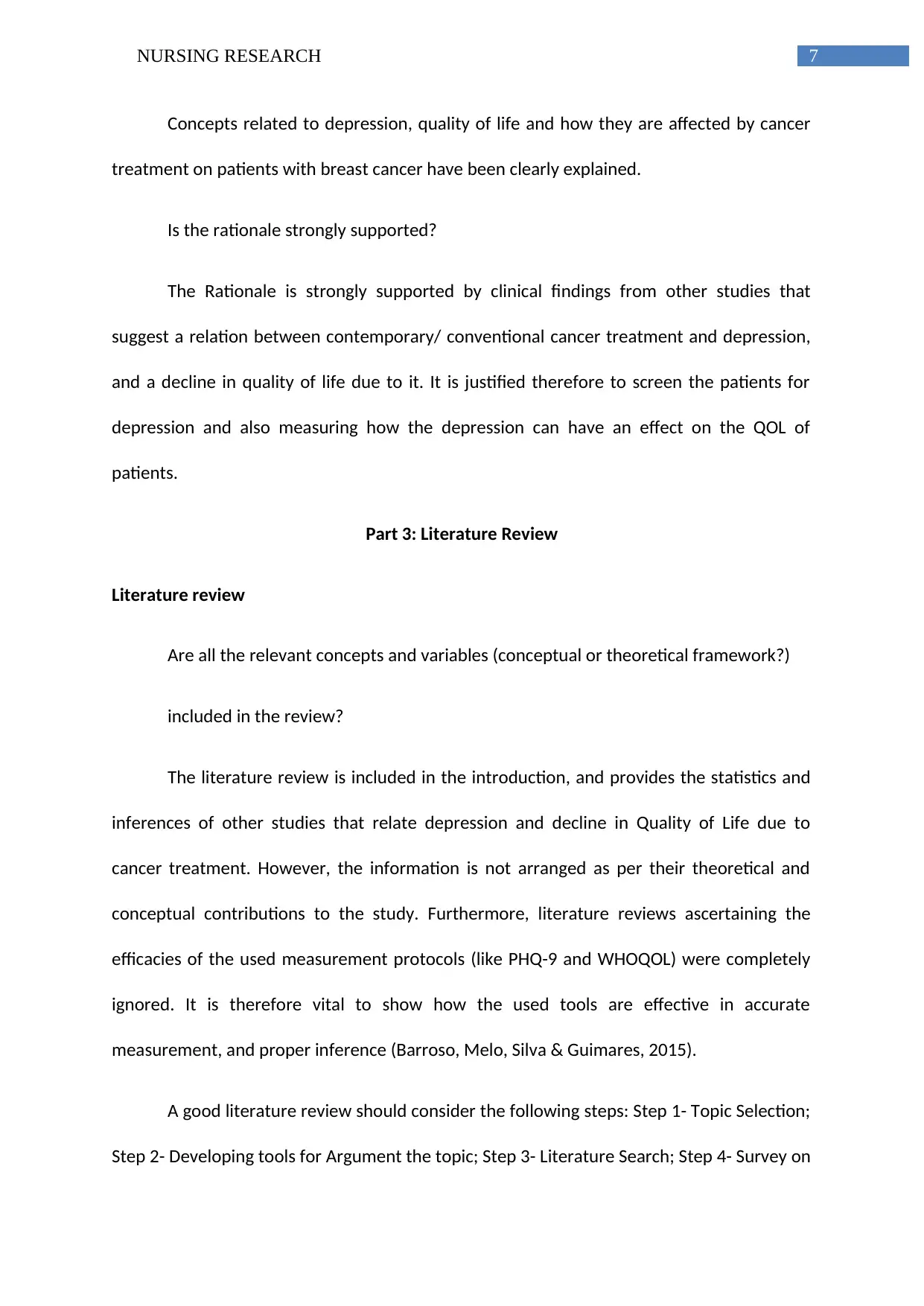
7NURSING RESEARCH
Concepts related to depression, quality of life and how they are affected by cancer
treatment on patients with breast cancer have been clearly explained.
Is the rationale strongly supported?
The Rationale is strongly supported by clinical findings from other studies that
suggest a relation between contemporary/ conventional cancer treatment and depression,
and a decline in quality of life due to it. It is justified therefore to screen the patients for
depression and also measuring how the depression can have an effect on the QOL of
patients.
Part 3: Literature Review
Literature review
Are all the relevant concepts and variables (conceptual or theoretical framework?)
included in the review?
The literature review is included in the introduction, and provides the statistics and
inferences of other studies that relate depression and decline in Quality of Life due to
cancer treatment. However, the information is not arranged as per their theoretical and
conceptual contributions to the study. Furthermore, literature reviews ascertaining the
efficacies of the used measurement protocols (like PHQ-9 and WHOQOL) were completely
ignored. It is therefore vital to show how the used tools are effective in accurate
measurement, and proper inference (Barroso, Melo, Silva & Guimares, 2015).
A good literature review should consider the following steps: Step 1- Topic Selection;
Step 2- Developing tools for Argument the topic; Step 3- Literature Search; Step 4- Survey on
Concepts related to depression, quality of life and how they are affected by cancer
treatment on patients with breast cancer have been clearly explained.
Is the rationale strongly supported?
The Rationale is strongly supported by clinical findings from other studies that
suggest a relation between contemporary/ conventional cancer treatment and depression,
and a decline in quality of life due to it. It is justified therefore to screen the patients for
depression and also measuring how the depression can have an effect on the QOL of
patients.
Part 3: Literature Review
Literature review
Are all the relevant concepts and variables (conceptual or theoretical framework?)
included in the review?
The literature review is included in the introduction, and provides the statistics and
inferences of other studies that relate depression and decline in Quality of Life due to
cancer treatment. However, the information is not arranged as per their theoretical and
conceptual contributions to the study. Furthermore, literature reviews ascertaining the
efficacies of the used measurement protocols (like PHQ-9 and WHOQOL) were completely
ignored. It is therefore vital to show how the used tools are effective in accurate
measurement, and proper inference (Barroso, Melo, Silva & Guimares, 2015).
A good literature review should consider the following steps: Step 1- Topic Selection;
Step 2- Developing tools for Argument the topic; Step 3- Literature Search; Step 4- Survey on
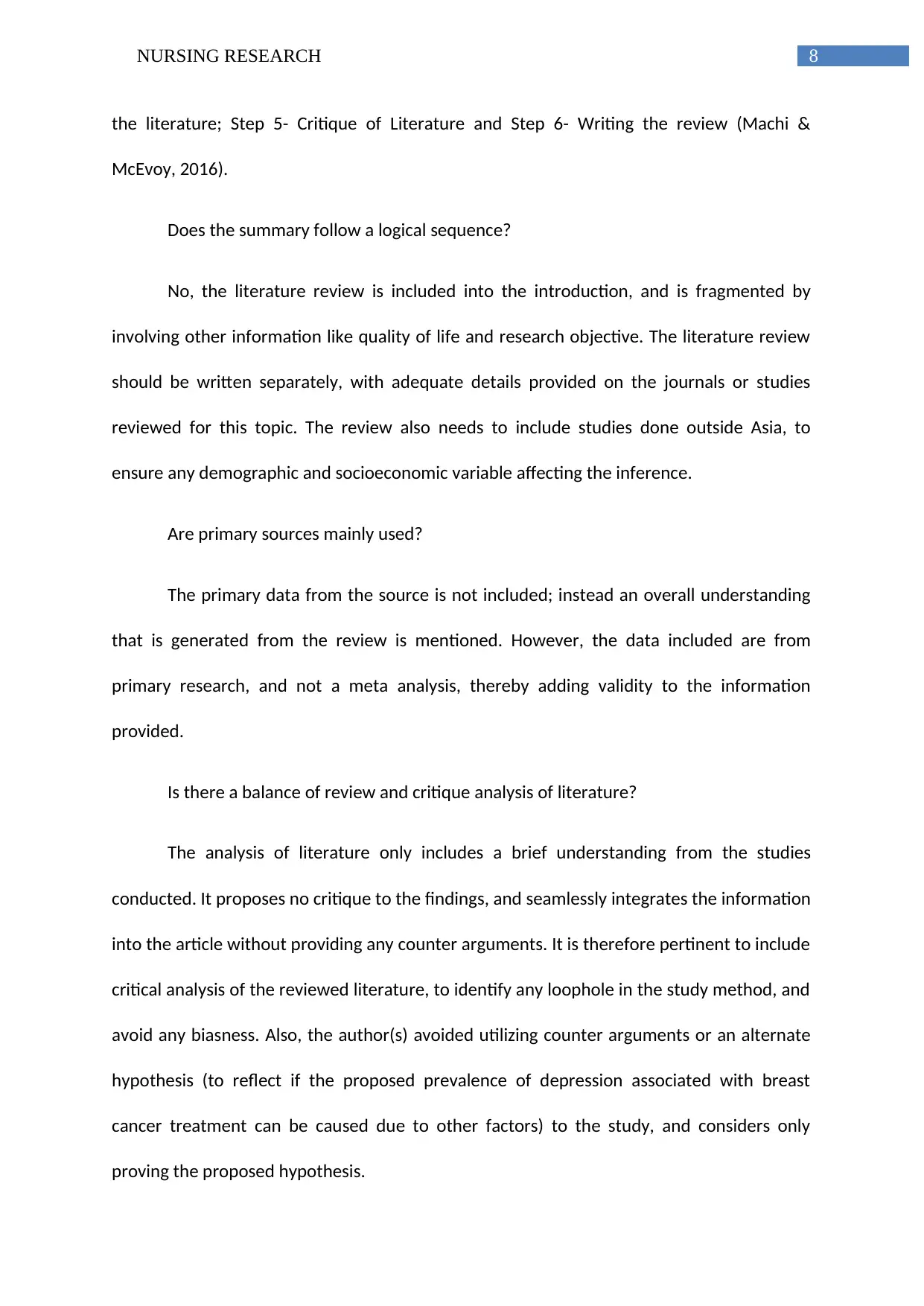
8NURSING RESEARCH
the literature; Step 5- Critique of Literature and Step 6- Writing the review (Machi &
McEvoy, 2016).
Does the summary follow a logical sequence?
No, the literature review is included into the introduction, and is fragmented by
involving other information like quality of life and research objective. The literature review
should be written separately, with adequate details provided on the journals or studies
reviewed for this topic. The review also needs to include studies done outside Asia, to
ensure any demographic and socioeconomic variable affecting the inference.
Are primary sources mainly used?
The primary data from the source is not included; instead an overall understanding
that is generated from the review is mentioned. However, the data included are from
primary research, and not a meta analysis, thereby adding validity to the information
provided.
Is there a balance of review and critique analysis of literature?
The analysis of literature only includes a brief understanding from the studies
conducted. It proposes no critique to the findings, and seamlessly integrates the information
into the article without providing any counter arguments. It is therefore pertinent to include
critical analysis of the reviewed literature, to identify any loophole in the study method, and
avoid any biasness. Also, the author(s) avoided utilizing counter arguments or an alternate
hypothesis (to reflect if the proposed prevalence of depression associated with breast
cancer treatment can be caused due to other factors) to the study, and considers only
proving the proposed hypothesis.
the literature; Step 5- Critique of Literature and Step 6- Writing the review (Machi &
McEvoy, 2016).
Does the summary follow a logical sequence?
No, the literature review is included into the introduction, and is fragmented by
involving other information like quality of life and research objective. The literature review
should be written separately, with adequate details provided on the journals or studies
reviewed for this topic. The review also needs to include studies done outside Asia, to
ensure any demographic and socioeconomic variable affecting the inference.
Are primary sources mainly used?
The primary data from the source is not included; instead an overall understanding
that is generated from the review is mentioned. However, the data included are from
primary research, and not a meta analysis, thereby adding validity to the information
provided.
Is there a balance of review and critique analysis of literature?
The analysis of literature only includes a brief understanding from the studies
conducted. It proposes no critique to the findings, and seamlessly integrates the information
into the article without providing any counter arguments. It is therefore pertinent to include
critical analysis of the reviewed literature, to identify any loophole in the study method, and
avoid any biasness. Also, the author(s) avoided utilizing counter arguments or an alternate
hypothesis (to reflect if the proposed prevalence of depression associated with breast
cancer treatment can be caused due to other factors) to the study, and considers only
proving the proposed hypothesis.
⊘ This is a preview!⊘
Do you want full access?
Subscribe today to unlock all pages.

Trusted by 1+ million students worldwide
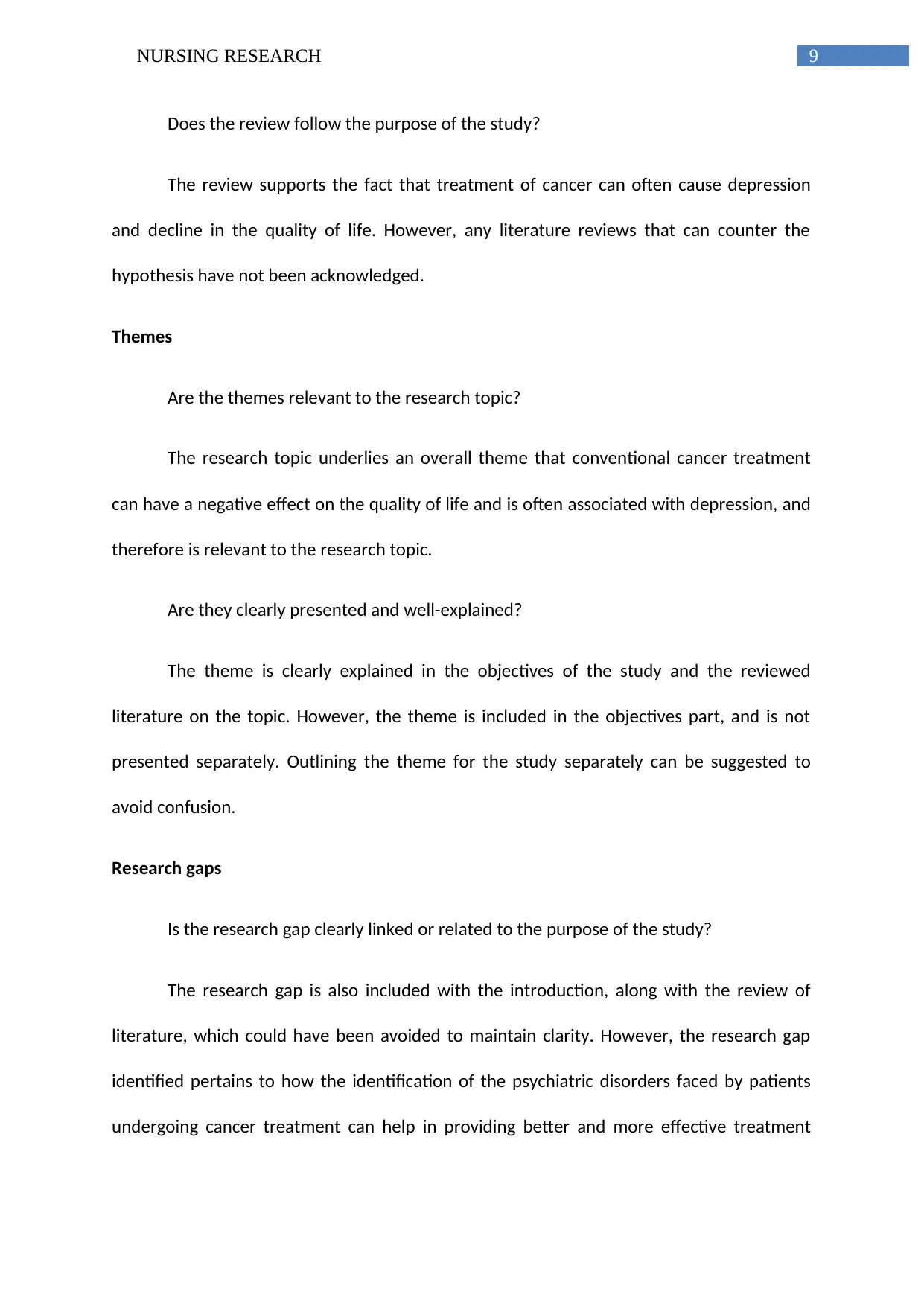
9NURSING RESEARCH
Does the review follow the purpose of the study?
The review supports the fact that treatment of cancer can often cause depression
and decline in the quality of life. However, any literature reviews that can counter the
hypothesis have not been acknowledged.
Themes
Are the themes relevant to the research topic?
The research topic underlies an overall theme that conventional cancer treatment
can have a negative effect on the quality of life and is often associated with depression, and
therefore is relevant to the research topic.
Are they clearly presented and well-explained?
The theme is clearly explained in the objectives of the study and the reviewed
literature on the topic. However, the theme is included in the objectives part, and is not
presented separately. Outlining the theme for the study separately can be suggested to
avoid confusion.
Research gaps
Is the research gap clearly linked or related to the purpose of the study?
The research gap is also included with the introduction, along with the review of
literature, which could have been avoided to maintain clarity. However, the research gap
identified pertains to how the identification of the psychiatric disorders faced by patients
undergoing cancer treatment can help in providing better and more effective treatment
Does the review follow the purpose of the study?
The review supports the fact that treatment of cancer can often cause depression
and decline in the quality of life. However, any literature reviews that can counter the
hypothesis have not been acknowledged.
Themes
Are the themes relevant to the research topic?
The research topic underlies an overall theme that conventional cancer treatment
can have a negative effect on the quality of life and is often associated with depression, and
therefore is relevant to the research topic.
Are they clearly presented and well-explained?
The theme is clearly explained in the objectives of the study and the reviewed
literature on the topic. However, the theme is included in the objectives part, and is not
presented separately. Outlining the theme for the study separately can be suggested to
avoid confusion.
Research gaps
Is the research gap clearly linked or related to the purpose of the study?
The research gap is also included with the introduction, along with the review of
literature, which could have been avoided to maintain clarity. However, the research gap
identified pertains to how the identification of the psychiatric disorders faced by patients
undergoing cancer treatment can help in providing better and more effective treatment
Paraphrase This Document
Need a fresh take? Get an instant paraphrase of this document with our AI Paraphraser
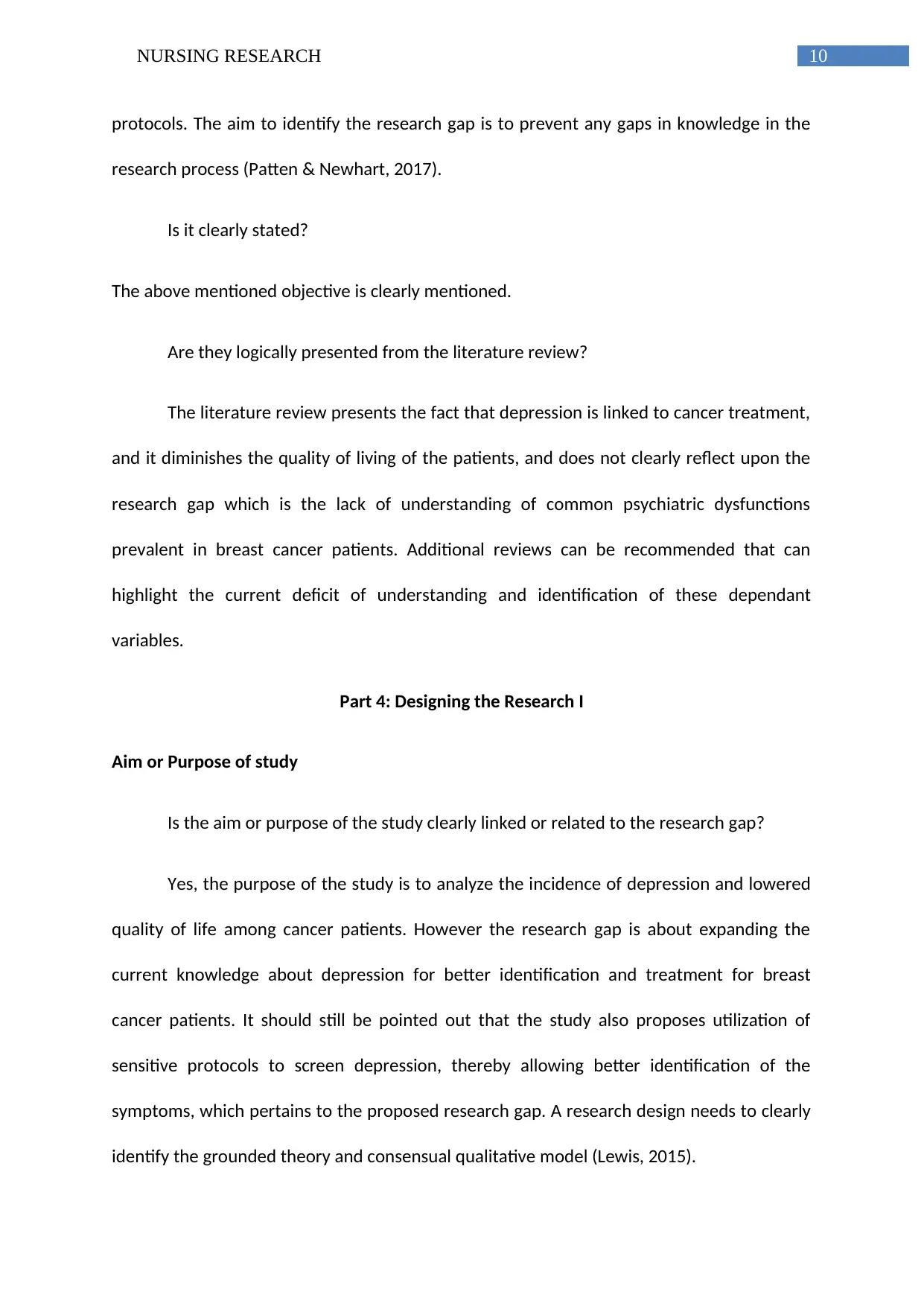
10NURSING RESEARCH
protocols. The aim to identify the research gap is to prevent any gaps in knowledge in the
research process (Patten & Newhart, 2017).
Is it clearly stated?
The above mentioned objective is clearly mentioned.
Are they logically presented from the literature review?
The literature review presents the fact that depression is linked to cancer treatment,
and it diminishes the quality of living of the patients, and does not clearly reflect upon the
research gap which is the lack of understanding of common psychiatric dysfunctions
prevalent in breast cancer patients. Additional reviews can be recommended that can
highlight the current deficit of understanding and identification of these dependant
variables.
Part 4: Designing the Research I
Aim or Purpose of study
Is the aim or purpose of the study clearly linked or related to the research gap?
Yes, the purpose of the study is to analyze the incidence of depression and lowered
quality of life among cancer patients. However the research gap is about expanding the
current knowledge about depression for better identification and treatment for breast
cancer patients. It should still be pointed out that the study also proposes utilization of
sensitive protocols to screen depression, thereby allowing better identification of the
symptoms, which pertains to the proposed research gap. A research design needs to clearly
identify the grounded theory and consensual qualitative model (Lewis, 2015).
protocols. The aim to identify the research gap is to prevent any gaps in knowledge in the
research process (Patten & Newhart, 2017).
Is it clearly stated?
The above mentioned objective is clearly mentioned.
Are they logically presented from the literature review?
The literature review presents the fact that depression is linked to cancer treatment,
and it diminishes the quality of living of the patients, and does not clearly reflect upon the
research gap which is the lack of understanding of common psychiatric dysfunctions
prevalent in breast cancer patients. Additional reviews can be recommended that can
highlight the current deficit of understanding and identification of these dependant
variables.
Part 4: Designing the Research I
Aim or Purpose of study
Is the aim or purpose of the study clearly linked or related to the research gap?
Yes, the purpose of the study is to analyze the incidence of depression and lowered
quality of life among cancer patients. However the research gap is about expanding the
current knowledge about depression for better identification and treatment for breast
cancer patients. It should still be pointed out that the study also proposes utilization of
sensitive protocols to screen depression, thereby allowing better identification of the
symptoms, which pertains to the proposed research gap. A research design needs to clearly
identify the grounded theory and consensual qualitative model (Lewis, 2015).
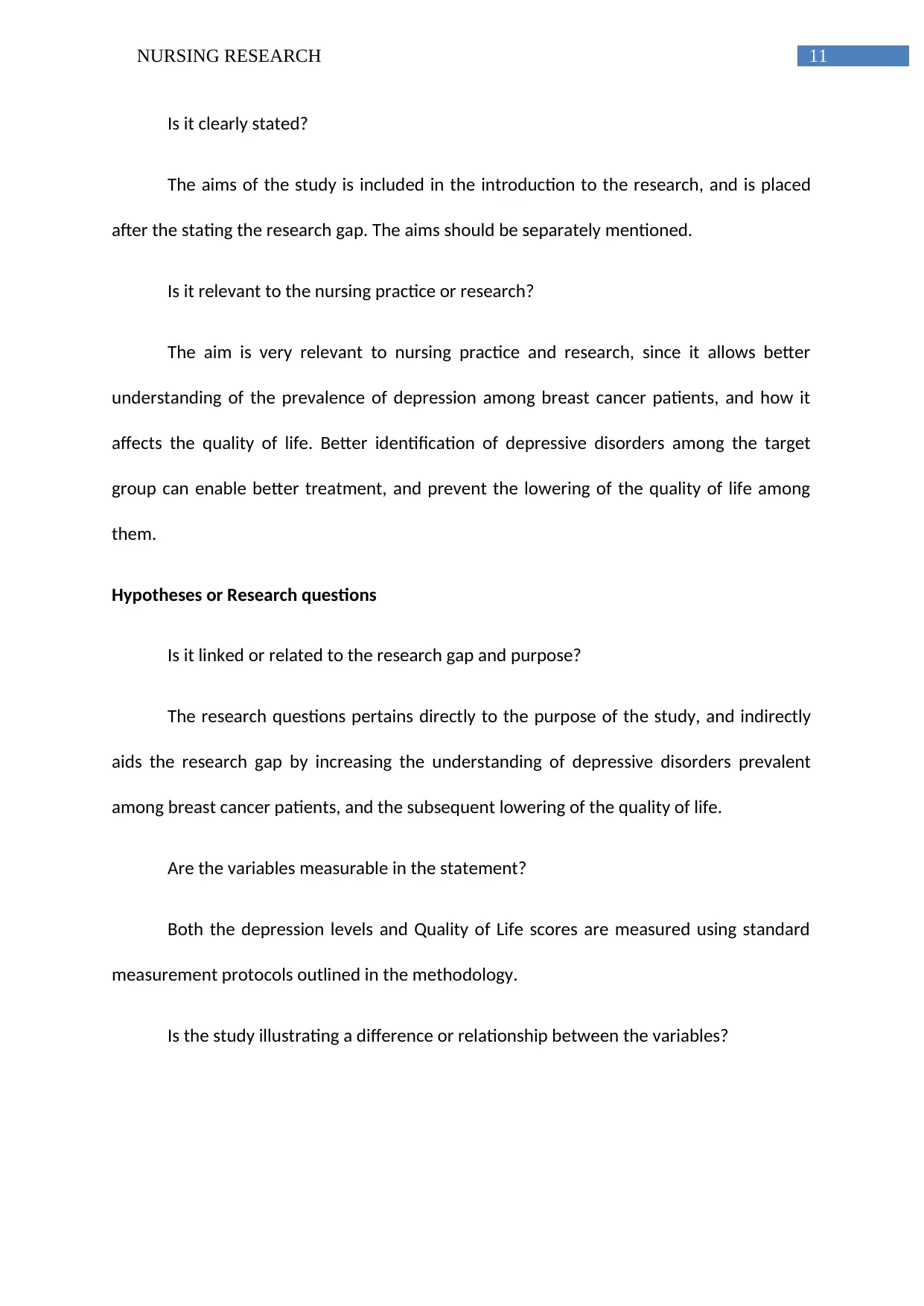
11NURSING RESEARCH
Is it clearly stated?
The aims of the study is included in the introduction to the research, and is placed
after the stating the research gap. The aims should be separately mentioned.
Is it relevant to the nursing practice or research?
The aim is very relevant to nursing practice and research, since it allows better
understanding of the prevalence of depression among breast cancer patients, and how it
affects the quality of life. Better identification of depressive disorders among the target
group can enable better treatment, and prevent the lowering of the quality of life among
them.
Hypotheses or Research questions
Is it linked or related to the research gap and purpose?
The research questions pertains directly to the purpose of the study, and indirectly
aids the research gap by increasing the understanding of depressive disorders prevalent
among breast cancer patients, and the subsequent lowering of the quality of life.
Are the variables measurable in the statement?
Both the depression levels and Quality of Life scores are measured using standard
measurement protocols outlined in the methodology.
Is the study illustrating a difference or relationship between the variables?
Is it clearly stated?
The aims of the study is included in the introduction to the research, and is placed
after the stating the research gap. The aims should be separately mentioned.
Is it relevant to the nursing practice or research?
The aim is very relevant to nursing practice and research, since it allows better
understanding of the prevalence of depression among breast cancer patients, and how it
affects the quality of life. Better identification of depressive disorders among the target
group can enable better treatment, and prevent the lowering of the quality of life among
them.
Hypotheses or Research questions
Is it linked or related to the research gap and purpose?
The research questions pertains directly to the purpose of the study, and indirectly
aids the research gap by increasing the understanding of depressive disorders prevalent
among breast cancer patients, and the subsequent lowering of the quality of life.
Are the variables measurable in the statement?
Both the depression levels and Quality of Life scores are measured using standard
measurement protocols outlined in the methodology.
Is the study illustrating a difference or relationship between the variables?
⊘ This is a preview!⊘
Do you want full access?
Subscribe today to unlock all pages.

Trusted by 1+ million students worldwide
1 out of 23
Your All-in-One AI-Powered Toolkit for Academic Success.
+13062052269
info@desklib.com
Available 24*7 on WhatsApp / Email
![[object Object]](/_next/static/media/star-bottom.7253800d.svg)
Unlock your academic potential
Copyright © 2020–2025 A2Z Services. All Rights Reserved. Developed and managed by ZUCOL.
